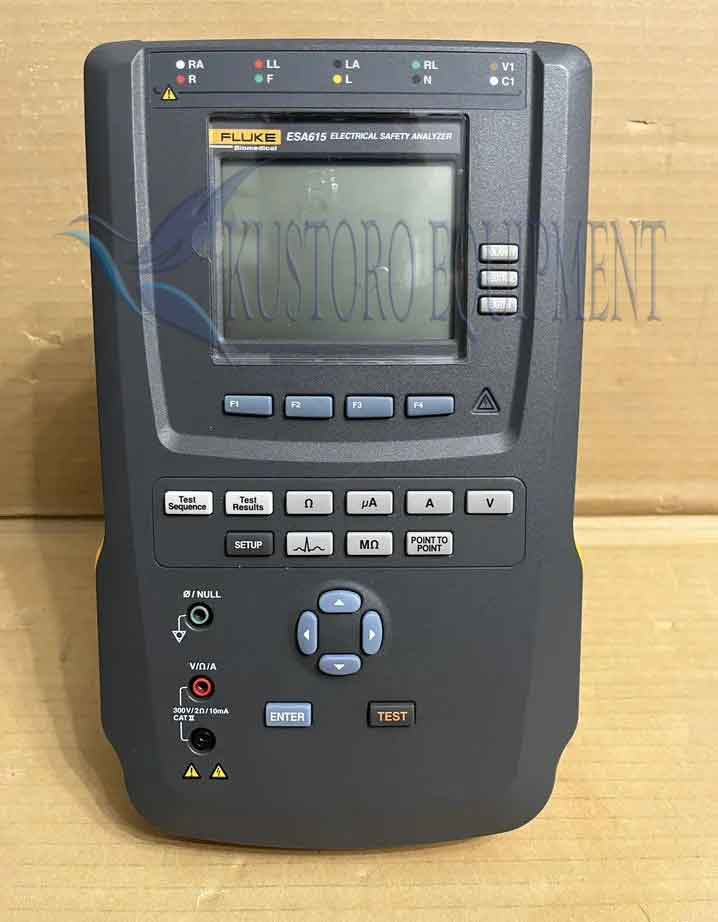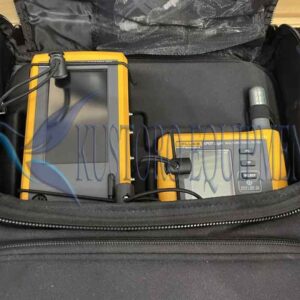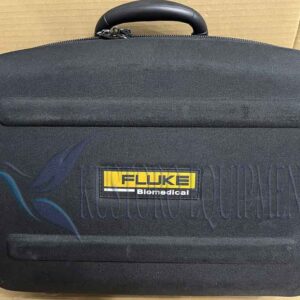Description
Fluke ProSim 8 Vital Signs and ECG Patient Simulator
Fluke ProSim 8 Vital Signs Patient Monitor Simulator by Fluke Biomedical is an all-in-one, portable simulator featuring a user-friendly design that helps healthcare technology maintenance and clinical bioengineering departments to efficiently meet compliance needs by enabling preventive maintenance testing with a single device, reducing average test time by up to 88%.
Designed to make comprehensive patient monitor testing quick and easy, the ProSim 8 tests eight vital sign parameters that are synchronized with one another, just as in the human body. It offers total patient monitor quality and safety testing, from non-invasive blood pressure (NIBP), static pressure linearity and dynamic pressure repeatability tests, EC13 and ACLS ECG waveforms, to complete Nellcor and Nonin SpO2 low perfusion and Masimo Rainbow SET, all in a single, 5-minute PM testing tool. While specialized, stay-connected ECG posts ensure secure lead connections.
Wireless PC communication, customized presets, auto-sequences, barcode scanning, onboard memory, direct data capture, printing functions and single-step adjustability helps Fluke ProSim 8 maximize testing productivity. Weighing in at a compact 4.2 lbs. (1.87 kg), it’s smaller and lighter than Fluke Biomedical’s previous generation of single function simulator test tools. And last, but certainly not least, a carrying case doubles as a mobile workstation.
Key Features Fluke ProSim 8 :
- All-in-one patient simulator 80% smaller and 17 lbs./7.7 kilos lighter than single function simulator test tools
- Fluke ProSim 8 are 8-in-1 multifunction patient simulator is a combination ECG simulator, fetal simulator, arrhythmia simulator, respiration simulator, temperature simulator, IBP simulator, cardiac output simulator, cardiac catheterization simulator, NIBP simulator, SpO2 tester, and is the premier SpO2 simulator to test Rainbow multi-wavelength waveforms
- Stay-connected ECG posts for easy/secure ECG snap and lead connections
- Custom SpO2 R-curve for accurate testing of the latest and future oximetry technologies
- Static pressure linearity testing
- Repeatable NIBP simulation for dynamic pressure repeatability testing
- Physiologically synchronized pulses across all parameters
- Barcode scanning and direct data capture and printing functionality
- Onboard, customizable patient pre-sets and auto sequences for fast/easy testing
- Multi-language user interface offers choice of language selection
- Integrated, easily-replaceable long-life battery
- Optional PC-interface software offers customizable procedures/checklists and automated data capture/storage
- Wireless communication for remote PC control of test device, as well as data transfer and automated regulatory reporting
Specifications Fluke ProSim 8
|
General Specifications |
|
| Temperature | Operating: 10 °C to 40 °C (50 °F to 104 °F) Storage: -20 °C to +60 °C (-4 °F to 140 °F) |
| Humidity | 10 % to 90 % non-condensing |
| Altitude | 3,000 meters (9,843 ft) |
| Dimensions (L x W x H) | 14.5 cm x 30.2 cm x 8.6 cm (5.7 in x 11.9 in x 3.4 in) |
| Display | LCD color display |
| Communication | USB device upstream port: Mini-B connector for control by a computer USB host controller port: Type A, 5 V output, 0.5 A max load. Connector for keyboard, barcode reader, and printer Wireless: IEEE 82.15.4 for control by a computer |
| Power | Lithium-ion rechargeable battery |
| Battery charger | 100 V to 240 V input, 15 V/2.0 A output. For best performance, the battery charger should be connected to a properly-grounded ac receptacle |
| Battery life | 9 hours (minimum), 100 NIBP cycles typical |
| Weight | 1.87 kg (4.2 lb) |
| Safety standards | EN/IEC 61010-1:2001 |
| Certifications | CE, CSA, C-TICK N10140 , RoHS |
| Electromagnetic compatibility (EMC) | IEC 61326-1:2006 |
|
Detailed Specifications |
|
| Normal-sinus-rhythm waveform | |
| ECG reference | The ECG amplitudes specified are for Lead II (calibration), from the baseline to the peak of the R wave. All other leads are proportional |
| Normal sinus rhythm | 12-lead configuration with independent outputs referenced to right leg (RL). Output to 10 universal ECG jacks, color-coded to AHA and IEC standards |
| High-level output | 0.5 V/mV ± 5 % of the ECG amplitude setting available on a BNC connector |
| Amplitude | 0.05 mV to 0.5 mV (0.05 mV steps); 0.5 mV to 5.0 mV (0.25 mV steps) Other leads are proportional to Lead II (reference lead) in percentage per: Lead I: 70 Lead II: 100 Lead III: 30 Lead V1: 24 Lead V2: 48 Lead V3: 100 Lead V4: 120 Lead V5: 112 Lead V6: 80 |
| Amplitude accuracy | ± (2 % of setting + 0.05 mV) |
| ECG rate | 10 BPM to 360 BPM in 1 BPM steps |
| Rate accuracy | ± 1 % of setting |
| ECG waveform selection | Adult (80 ms) or pediatric (40 ms) QRS duration |
| ST-segment elevation | Adult mode only. -0.8 mV to +0.8 mV (0.1 mV steps). Additional steps: + 0.05 mV and – 0.05 mV |
| Power-on default | 60 BPM, 1.0 mV, adult QRS and ST-segment elevation of 0 mV |
|
Pacemaker waveform |
|
| Pacer pulse | Amplitude: 0 (off), ± 2, ± 4, ± 6, ± 8, ± 10, ± 12, ± 14, ± 16, ± 18, ± 20, ± 50, ± 100, ± 200, ± 500, and ± 700 mV for lead II (reference lead) Accuracy: Reference lead II: ± (5 % setting + 0.2 mV) All other leads: ± (10 % setting + 0.4 mV) |
| Pacer pulse width | 0.1 ms, 0.2 ms, 0.5 ms, 1 ms, and 2 ms ± 5 % |
| Paced arrhythmias | Atrial 80 BPM Asynchronous 75 BPM Demand with frequent sinus beats Demand with occasional sinus beats Atrio-ventricular sequential Noncapture (one time) Nonfunction |
| Power-on default | Amplitude 5 mV, width 1 ms, atrial waveform |
|
Arrhythmia |
|
| Baseline NSR | 80 BPM |
| PVC focus | Left focus, standard timing (except where specified) |
| Supraventricular arrhythmia | Atrial fibrillation (coarse or fine); atrial flutter; sinus arrhythmia; missed beat (one time); atrial tachycardia; paroxysmal atrial tachcardia; nodal rhythm; and supraventricular tachycardia |
| Premature arrhythmia | Premature atrial contraction (PAC); premature nodal contraction (PNC); PVC1 left ventricular; PVC1 left ventricular, early; PVC1 left ventricular, R on T; PVC2 right ventricular; PVC2 right ventricular, early; PVC2 right ventricular, R on T; and multifocal PVCs |
| Ventricular arrhythmia | PVCs 6, 12, or 24 per minute; frequent multifocal PVCs; bigeminy; trigeminy; multiple PVCs (one-time run of 2, 5, or 11 PVCs); monoventricular tachycardia (120 to 300 BPM in 5 BPM steps); poly-ventricular tachycardia (5 types); ventricular fibrillation (coarse or fine); and asystole |
| Conduction defect | First-, second-, or third-degree heart block; and right- or left-bundlebranch block |
| Advanced cardiac life support | Shockable pulseless arrest rhythms: Ventricular fibrillation (coarse), ventricular fibrillation (fine), unstable polymorphic ventricular tachycardia Non-shockable pulseless arrest rhythms: Asystole Symptomatic bradycardia: Sinus bradycardia (< 60 BPM) 2nd degree AV block, mobitz type I 2nd degree AV block, mobitz type II Complete/3rd degree AV block Right bundle branch block Left bundle branch block Symptomatic tachycardia: regular narrow-complex tachycardia (QRS < 0.12 seconds): Sinus tachycardia > 150 BPM Supraventricular Tachycardia Symptomatic tachycardia: regular wide-complex tachycardias (QRS ≥ 0.12 seconds): Sinus tachycardia > 150 BPM Supraventricular tachycardia SVT with aberrancy Irregular tachycardia: Atrial fibrillation (coarse and fine), atrial flutter, unstable monomorphic ventricular tachycardia (120 BPM to 300 BPM), torsade de pointes/polymorphic ventricular tachycardia (long QT interval) |
|
ECG Performance testing |
|
| Amplitude | 0.05 mV to 0.5 mV (0.05 mV steps); 0.5 mV to 5.0 mV (0.25 mV steps) Other leads are proportional to Lead II (reference lead) in percentage per: Lead I: 70 Lead II: 100 Lead III: 30 Lead V1 through V6: 100 |
| Pulse wave | 30 BPM, 60 BPM, with 60 ms pulse width |
| Square wave | 0.125 Hz, 2 Hz, 2.5 Hz |
| Triangle wave | 0.125 Hz, 2 Hz, 2.5 Hz |
| Sine wave | 0.05 Hz, 0.5 Hz, 1, 2 Hz, 5 Hz, 10 Hz, 25 Hz, 30 Hz, 40 Hz, 50 Hz, 60 Hz, 100 Hz, and 150 Hz |
| R-wave detection | Waveform: Triangular pulse Rate: 30 BPM, 60 BPM, 80 BPM, 120 BPM, 200 BPM, and 250 BPM Width: 8 ms to 20 ms in 2 ms steps, and 20 ms to 200 ms in 10 ms steps Width accuracy: ± (1 % of setting + 1 ms) |
| QRS detection | Widths 8 ms to 20 ms in 2 ms steps, and 20 ms to 200 ms in 10 ms steps Width accuracy ± (1 % of setting + 1 ms) Rate 30 BPM, 60 BPM, 80 BPM, 120 BPM, 200 BPM, and 250 BPM R-Wave up slope 0.875 amplitude, 0.4375 x width R-Wave down slope Full amplitude, 0.5 x width S-Wave up slope 0.125 amplitude, 0.0625 x width |
| Tall T-wave rejection | Waveform QT Interval 350 ms T-Wave width 180 ms T-Wave shape ½ sinewave Amplitude 0 % to 150 % reference lead amplitude in 10 % steps Rate 80 BPM |
| Rate accuracy | ± 1 % of setting |
| Amplitute accuracy | ± (2 % of setting + 0.05 mV) |
|
ECG artifact |
|
| Type | 50 Hz, 60 Hz, muscular, baseline wander, respiration |
| Size | 25 %, 50 %, 100 % of the normal sinus R-Wave for each lead |
| Lead select | All, RA, LL, LA, V1, V2, V3, V4, V5, V6 |
|
Fetal/Maternal ECG |
|
| Fetal heart rate (fixed) | 60 BPM to 240 BPM in 1 BPM steps |
| Fetal heart rate (IUP) | 140 BPM at beginning, then varies with pressure |
| Intrauterine-pressure waveforms | Early deceleration, late deceleration, and acceleration |
| Wave duration | 90 seconds, bell-shaped pressure curve, from 0 mmHg to 90 mmHg and returning to 0 |
| IUP period | 2 min, 3 min, or 5 minutes; and manual |
| Default settings | FHR 140 BPM, early deceleration wave, manual |
|
Invasive blood pressure |
|
| Channels | 2, each independently settable with identical parameters and are individually electrically isolated from all other signals |
| Input/output impedance | 300 Ω ± 10 % |
| Exciter input range | 2 to 16 V peak |
| Exciter-input frequency range | DC to 5000 Hz |
| Transducer sensitivity | 5 (default) or 40 µV/V/mmHg |
| Pressure accuracy | ± (1 % of setting + 1 mmHg) accuracy guaranteed for dc excitation only |
| Static pressure | – 10 to + 300 mmHg in 1 mmHg steps |
| Pressure units | mmHg or Kpa |
| Dynamic waveforms | Types (default pressures): Arterial (120/80) Radial artery (120/80) Left ventricle (120/00) Right ventricle (25/00) Pulmonary artery (25/10) Pulmonary-artery wedge (10/2) Right atrium (central venous or CVP) (15/10) Pressure variability: Systolic and diastolic pressures are independently variable in 1 mmHg steps |
| Swan-Ganz sequence | Right atrium, right ventrical (RV), pulmonary artery (PA), pulmonary artery wedge (PAW) |
| Cardiac catheterization | Chambers: Aortic, pulmonary valve, and mitral valve |
| Respiration artifact | Arterial, radial artery, and left ventricle: 5 % to 10 % multiplication Other: 5 mmHg or 10 mmHg |
| BP output | Circular DIN 5-Pin |
| Power-on default | 0 mmHg |
|
Respiration |
|
| Rate | 0 (OFF), 10 BrPM to 150 BrPM in 1 BrPM steps |
| Waves | Normal or ventilated |
| Ratio (inspiration:expiration) | Normal 1:1, 1:2, 1:3, 1:4, 1:5 Ventilated 1:1 |
| Impedance variations (Δ Ω) | 0.00 Ω to 1.00 Ω in 0.05 Ω steps and 1 Ω to 5 Ω in 0.25 Ω steps |
| Accuracy delta | ± (5 % of setting + 0.1 Ω) |
| Baseline | 500 Ω, 1000 Ω (default), 1500 Ω, 2000 Ω, Leads I, II, III |
| Accuracy baseline | ± 5 % |
| Respiration lead | LA or LL (default) |
| Apnea selection | 12 sec, 22 sec, or 32 seconds (one-time events), or continuous (Apnea ON = respiration OFF) |
| Power-on default | 20 BrPM, delta 1.0 Ω |
|
Temperature |
|
| Temperature | 3.0 °C to 42.0 °C in 0.5 °C steps |
| Accuracy | ± 0.4 °C |
| Compatibility | Yellow Springs, Inc. (YSI) Series 400 and 700 |
| Output | Circular DIN 4-Pin |
|
Cardiac output |
|
| Catheter type | Baxter Edwards, 93a-131-7f |
| Calibration coeffecient | 0.542 (0 °C injectate), 0.595 (24 °C injectate) |
| Blood temperature | 36 °C (98.6 °F) to 38 °C (100.4 °F) ± 0.2 °C in 1 °C steps |
| Injectate volume | 10 cc |
| Injectate temperature | 0 °C or 24 °C |
| Cardiac output | 2.5, 5, 10 liters per minute ± 7.5 % |
| Faulty-injectate curve | Waveform for simulation available |
| Left-to-right-shunt curve | Waveform for simulation available |
| Calibrated pulse | 1.5 ° for 1 second |
| Connector | Circular DIN 7 pin |
| Power-on default | 5 liters per minute, 0 °C injectate, 37 °C blood temperature |
|
Non-invasive blood pressure |
|
| Pressure units | |
| Manometer (Pressure meter) | |
| Pressure source | |
| NIBP simulations | Pulse 2 mmHg max into 500 ml NIBP system Volume of air moved 1.25 ml max Simulations (systolic/diastolic [MAP]) Adult: 60/30 (40), 80/50 (60); 100/65 (77); 120/80 (93); 150/100 (117); and 200/150 (167) and 255/195 (215) Neonatal: 35/15 (22); 60/30 (40); 80/50 (60); 100/65 (77); 120/80 (93) and 150/100 Pressure variability: systolic and diastolic pressures are variable by 1 mmHg Repeatability Within ± 2 mmHg (at maximum pulse size independent of device under test) Synchronization: normal Sinus heart rates: 30 BPM to 240 BPM Maximum rate at 1 ml: 240 BPM achievable with pulses up to 1 ml Maximum rate at 1.25 ml: 180 BPM Synchronization: arrhythmias Premature atrial contraction (PAC), premature ventricular contraction (PVC), atrial fibrillation, and missed beat |
| Leak test | Target pressure 20 mmHg to 400 mmHg Elapse time 0:30 min to 5:00 minutes: seconds in 30 second steps Leakage rate 0 mmHg/minute to 200 mmHg/ minute |
| Pressure relief test range | 100 to 400 mmHg |
Package Include
- Fluke Biomedical ProSim 8 Vital Signs Simulator
- AC Adapter/Charger
- USB PC Interface Cable
- User Manual On CD-ROM
- Hard Carrying Case
Additional information
| Lead Time | 5-7 days |
|---|---|
| Packaging | Box |



























Reviews
There are no reviews yet.